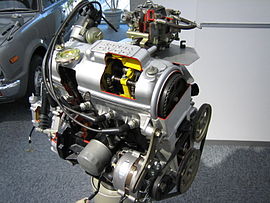- CVCC
-
CVCC can also be used to represent a consonant-vowel-consonant-consonant syllable pattern.A CVCC engine for Honda Civic

CVCC is a trademark by the Honda Motor Company for an engine with reduced automotive emissions, which stood for "Compound Vortex Controlled Combustion".[1] This technology allowed Honda's cars to meet United States emission standards in the 1970s without a catalytic converter. A type of stratified charge engine, it first appeared on the 1975 ED1 engine.
In 2007, the Honda CVCC technology was added to the Mechanical Engineering Heritage of Japan.
Contents
Construction and operation
Honda CVCC engines have normal inlet and exhaust valves, plus a small auxiliary inlet valve which provides a relatively rich air–fuel mixture to a volume near the spark plug. The remaining air–fuel charge, drawn into the cylinder through the main inlet valve, is leaner than normal. The volume near the spark plug is contained by a small perforated metal plate. Upon ignition flame fronts emerge from the perforations and ignite the remainder of the air–fuel charge. The remaining engine cycle is as per a standard four stroke engine.
This combination of a rich mixture near the spark plug, and a lean mixture in the cylinder allowed stable running, yet complete combustion of fuel, thus reducing CO (carbon monoxide) and hydrocarbon emissions.
Advantages over previous stratified charge engines
Honda's big advancement with CVCC was that they were able to use carburettors and they did not rely on intake swirl. Previous versions of stratified charge engines needed costly fuel injection systems. Additionally, previous engines tried to increase the velocity and swirl of the intake charge in keeping the rich and lean mixtures separated. Honda was able to keep the charges adequately separated by combustion chamber shape.
Early design flaw
Some of the early CVCC engines had a problem with the auxiliary valves retaining collars vibrating loose. Once unscrewed, engine oil would leak from the valvetrain into the pre-combustion chamber, causing a sudden loss of power and massive amounts of smoke to emanate from the exhaust pipe. The condition simulated a blown engine, even though the needed repair was quite simple. Honda eventually came up with a fix involving metal retaining rings that slipped over the collars and prevented them from backing out of their threads.
CVCC-II
The 1983 Honda Prelude (the first year of the second generation of Preludes) used a CVCC design and a catalytic converter to reduce emissions, called CVCC-II, along with 2 separate sidedraught carburettors (instead of a single progressive twin choke carburettor). The following year a standard cylinder head design was used and the centre carburettor (providing the rich mixture) was dropped. The Honda City AA, introduced in November 1981, also used a CVCC-II engine called the ER.[2]
References/Reading
- ^ Honda Worldwide
- ^ World Cars 1985. Pelham, NY: The Automobile Club of Italy/Herald Books. 1985. pp. 345–346. ISBN 0-910714-17-7.
- Setright, L. J. K. (1975). Some Unusual Engines. London: Mechanical Engineering Publications Limited.
- An Evaluation of a 350 CID Compound Vortex Controlled Combustion (CVCC) Powered Chevrolet Impala
Categories:- Engine technology
- Engines
Wikimedia Foundation. 2010.

